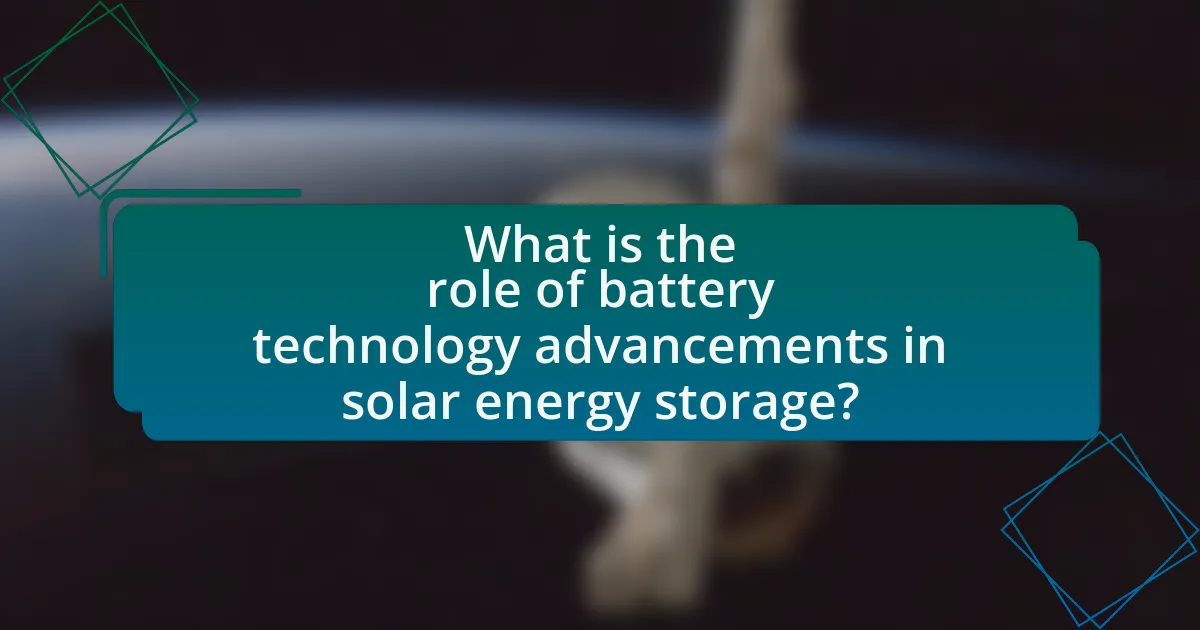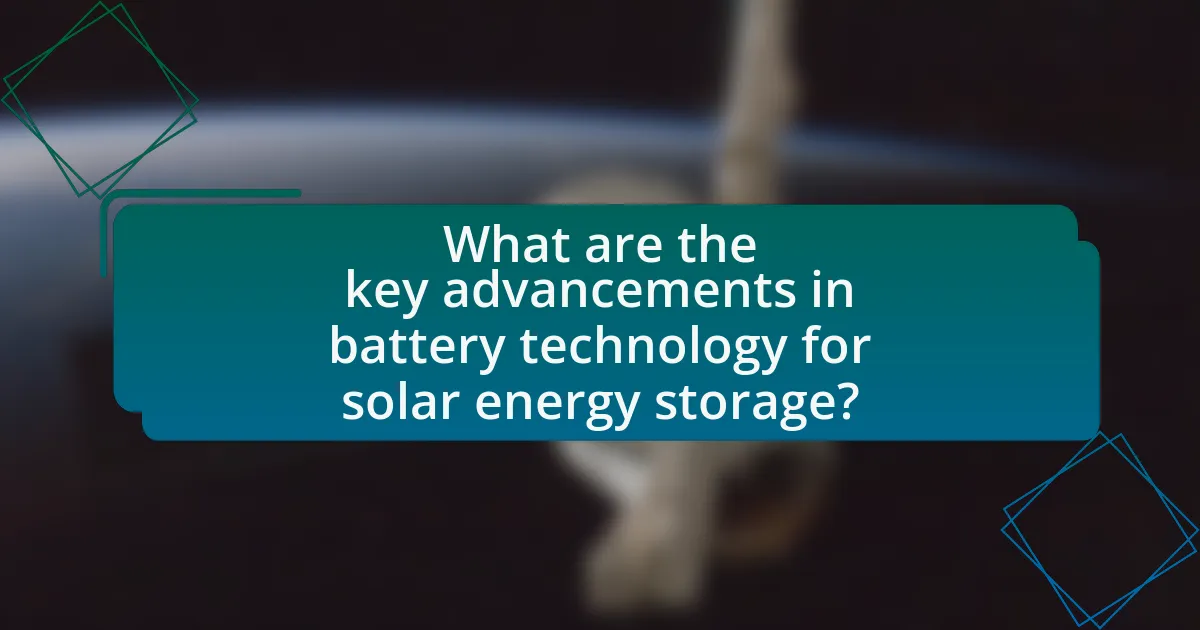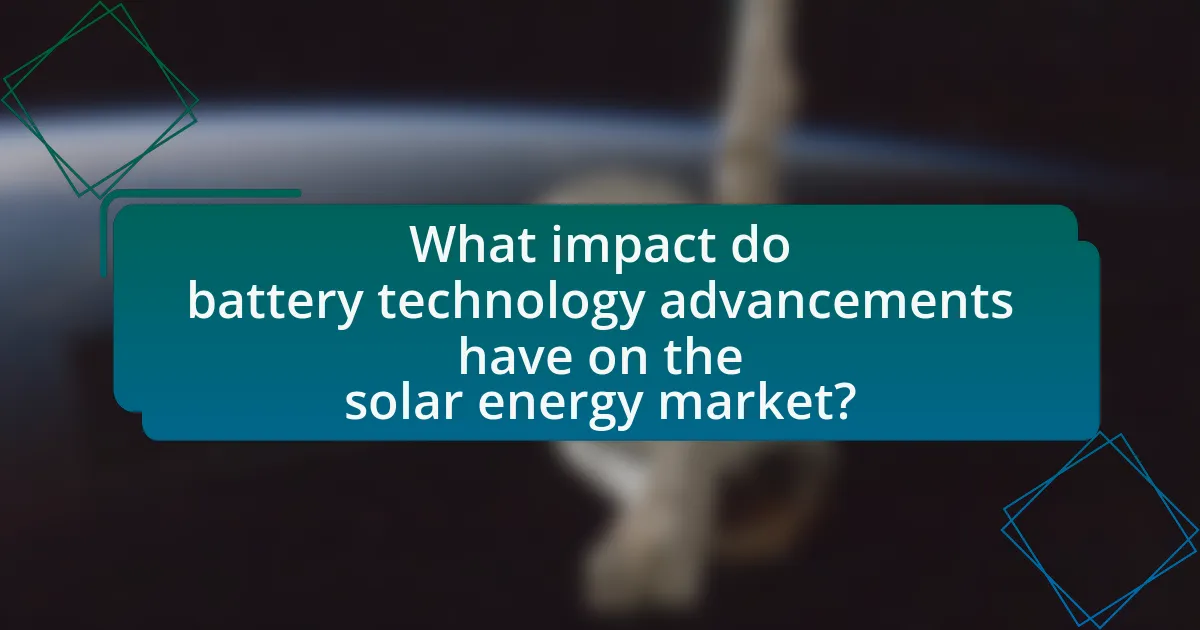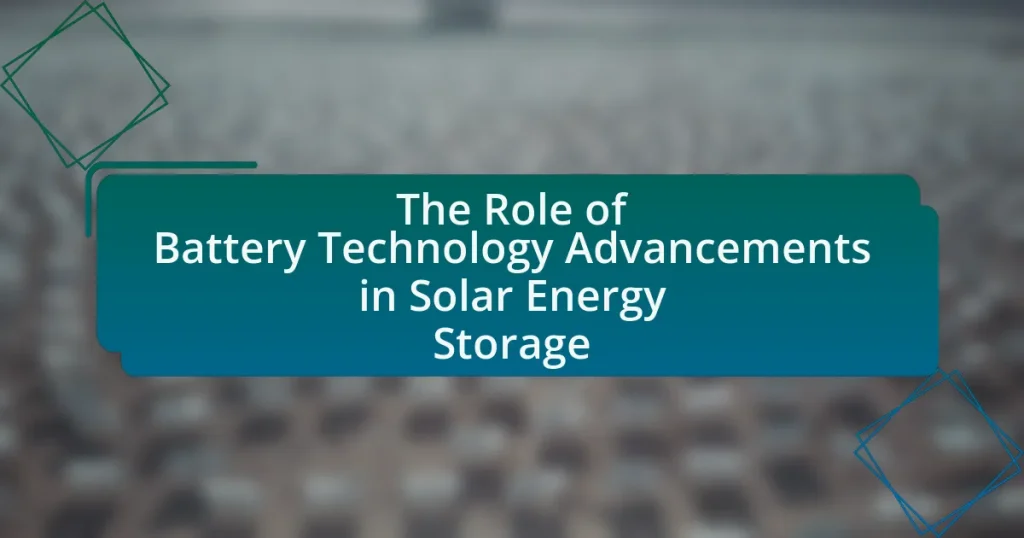Battery technology advancements are pivotal in enhancing solar energy storage systems by improving efficiency, capacity, and lifespan. Key technologies such as lithium-ion, solid-state, and flow batteries enable better energy retention and faster charging, addressing the intermittent nature of solar power. The article explores various battery types, their performance differences, and the impact of innovations on solar energy adoption, costs, and environmental sustainability. Additionally, it discusses the challenges faced without advanced battery technology and highlights best practices for integrating these technologies into solar energy systems.
What is the role of battery technology advancements in solar energy storage?


Battery technology advancements play a crucial role in enhancing solar energy storage by improving efficiency, capacity, and lifespan of storage systems. These advancements, such as the development of lithium-ion and solid-state batteries, enable better energy retention and faster charging times, which are essential for maximizing the utility of solar energy. For instance, lithium-ion batteries have become the standard due to their high energy density and longer cycle life, allowing for more effective storage of solar energy generated during peak sunlight hours. Additionally, innovations like flow batteries and advanced battery management systems contribute to increased scalability and safety, making solar energy more reliable and accessible.
How do battery technologies enhance solar energy storage systems?
Battery technologies enhance solar energy storage systems by improving energy efficiency, increasing storage capacity, and enabling faster charging and discharging cycles. Advanced battery technologies, such as lithium-ion and flow batteries, offer higher energy density, allowing for more energy to be stored in a smaller footprint. For instance, lithium-ion batteries can achieve energy densities of up to 250 Wh/kg, significantly outperforming traditional lead-acid batteries, which typically offer around 30-50 Wh/kg. Additionally, these technologies facilitate better integration with solar panels, allowing for optimized energy management and utilization, which is crucial for maximizing the benefits of solar energy.
What types of battery technologies are currently used in solar energy storage?
The types of battery technologies currently used in solar energy storage include lithium-ion, lead-acid, flow batteries, and nickel-cadmium batteries. Lithium-ion batteries dominate the market due to their high energy density, efficiency, and decreasing costs, making them suitable for residential and commercial solar systems. Lead-acid batteries, while older technology, are still used for their lower initial costs and reliability, particularly in off-grid applications. Flow batteries offer scalability and long cycle life, making them ideal for large-scale energy storage solutions. Nickel-cadmium batteries, although less common, are valued for their durability and performance in extreme temperatures. These technologies collectively enhance the efficiency and reliability of solar energy systems.
How do these battery technologies differ in performance and efficiency?
Battery technologies differ significantly in performance and efficiency, primarily in terms of energy density, charge/discharge rates, and cycle life. For instance, lithium-ion batteries typically offer higher energy density (150-250 Wh/kg) compared to lead-acid batteries (30-50 Wh/kg), allowing for more energy storage in a smaller volume. Additionally, lithium-ion batteries can achieve faster charge and discharge rates, often exceeding 1C, while lead-acid batteries generally operate at lower rates, around 0.1C to 0.3C. Furthermore, lithium-ion batteries have a longer cycle life, often exceeding 2,000 cycles, compared to lead-acid batteries, which usually last around 500-1,000 cycles. These differences make lithium-ion batteries more suitable for applications in solar energy storage, where efficiency and space are critical.
Why are advancements in battery technology crucial for solar energy adoption?
Advancements in battery technology are crucial for solar energy adoption because they enhance energy storage capacity, efficiency, and reliability. Improved batteries allow for the effective storage of solar energy generated during the day, making it available for use during periods of low sunlight or high demand. For instance, lithium-ion batteries, which have seen significant advancements, can now store more energy and have longer lifespans, facilitating a more stable and dependable energy supply. According to the International Energy Agency, energy storage capacity is projected to grow significantly, with battery storage expected to account for a substantial portion of this increase, thereby supporting the integration of solar energy into the grid.
What challenges do current solar energy systems face without advanced battery technology?
Current solar energy systems face significant challenges in energy storage and reliability without advanced battery technology. The primary issue is the intermittent nature of solar energy, which leads to periods of excess generation during sunny days and insufficient supply during cloudy days or at night. This variability results in a mismatch between energy production and consumption, making it difficult to ensure a consistent power supply.
Additionally, without advanced batteries, solar energy systems struggle with limited storage capacity, which restricts the amount of energy that can be stored for later use. For instance, traditional lead-acid batteries have a shorter lifespan and lower energy density compared to modern lithium-ion batteries, leading to higher costs and more frequent replacements.
Moreover, the lack of efficient energy management systems exacerbates these challenges, as current technologies may not effectively balance supply and demand, leading to energy waste or shortages. These factors collectively hinder the widespread adoption and effectiveness of solar energy systems, limiting their potential to contribute to a sustainable energy future.
How do advancements in battery technology address these challenges?
Advancements in battery technology address challenges in solar energy storage by improving energy density, cycle life, and charging speed. For instance, lithium-silicon batteries have shown potential to increase energy density significantly, allowing for more energy storage in a smaller footprint. Additionally, solid-state batteries enhance safety and longevity, reducing the risk of thermal runaway and extending the lifespan of energy storage systems. Research indicates that these advancements can lead to a 30% increase in efficiency and a reduction in costs by up to 50% over the next decade, making solar energy more viable and accessible.
What are the key advancements in battery technology for solar energy storage?


Key advancements in battery technology for solar energy storage include the development of lithium-sulfur batteries, solid-state batteries, and flow batteries. Lithium-sulfur batteries offer higher energy density and lower costs compared to traditional lithium-ion batteries, with research indicating they can achieve up to 500 Wh/kg, significantly enhancing storage capacity for solar energy. Solid-state batteries improve safety and longevity by using a solid electrolyte instead of a liquid one, which reduces the risk of leaks and fires; they also have the potential to double the energy density of current lithium-ion technologies. Flow batteries, particularly vanadium redox flow batteries, provide scalability and long cycle life, making them suitable for large-scale solar energy storage systems, with the ability to discharge energy over extended periods. These advancements collectively enhance the efficiency, safety, and cost-effectiveness of solar energy storage solutions.
What innovations have been made in battery chemistry?
Innovations in battery chemistry include the development of solid-state batteries, lithium-sulfur batteries, and sodium-ion batteries. Solid-state batteries utilize a solid electrolyte instead of a liquid one, enhancing safety and energy density, with companies like Toyota and QuantumScape leading research efforts. Lithium-sulfur batteries offer a higher theoretical energy density compared to traditional lithium-ion batteries, with advancements made by researchers at the University of Cambridge demonstrating improved cycle life and efficiency. Sodium-ion batteries present a cost-effective alternative to lithium-ion technology, with ongoing research by companies like Faradion showing promising results in energy storage applications. These innovations collectively aim to improve energy efficiency, safety, and sustainability in battery technology, particularly for solar energy storage systems.
How do lithium-ion batteries compare to other battery types in solar applications?
Lithium-ion batteries outperform other battery types in solar applications due to their higher energy density, longer cycle life, and faster charging capabilities. Specifically, lithium-ion batteries typically offer energy densities of 150-250 Wh/kg, compared to lead-acid batteries, which provide around 30-50 Wh/kg. This higher energy density allows for more efficient storage of solar energy, making them ideal for residential and commercial solar systems. Additionally, lithium-ion batteries can endure 2,000 to 5,000 charge cycles, significantly exceeding the 500-1,000 cycles of lead-acid batteries. This longevity translates to lower replacement costs and reduced environmental impact over time. Furthermore, lithium-ion technology supports rapid charging, enabling quicker energy storage from solar panels, which is crucial for maximizing solar energy utilization.
What role do solid-state batteries play in future solar energy storage?
Solid-state batteries are poised to significantly enhance future solar energy storage by offering higher energy density, improved safety, and longer lifespan compared to traditional lithium-ion batteries. These advantages enable more efficient storage of solar energy, allowing for greater energy retention and utilization during periods of low sunlight. Research indicates that solid-state batteries can achieve energy densities exceeding 300 Wh/kg, which is substantially higher than current lithium-ion technologies, thus maximizing the amount of energy stored from solar sources. Additionally, their solid electrolyte reduces the risk of flammability and thermal runaway, making them a safer option for residential and commercial solar energy systems.
How do battery management systems improve solar energy storage?
Battery management systems (BMS) enhance solar energy storage by optimizing the performance and lifespan of batteries. BMS achieves this through functions such as monitoring battery health, managing charge and discharge cycles, and ensuring safe operation by preventing overcharging or deep discharging. For instance, a study published in the Journal of Energy Storage highlights that effective BMS can increase battery lifespan by up to 30% by maintaining optimal operating conditions. Additionally, BMS enables better energy efficiency by balancing the charge across multiple battery cells, which maximizes the usable energy from solar systems.
What features do modern battery management systems offer?
Modern battery management systems (BMS) offer features such as state-of-charge (SOC) monitoring, state-of-health (SOH) assessment, thermal management, and cell balancing. These features ensure optimal performance, safety, and longevity of battery packs. SOC monitoring provides real-time data on the battery’s charge level, while SOH assessment evaluates the overall health and capacity of the battery over time. Thermal management regulates temperature to prevent overheating, which is critical for safety and efficiency. Cell balancing ensures that all cells within a battery pack charge and discharge evenly, enhancing performance and lifespan. These functionalities are essential for the effective integration of battery systems in solar energy storage applications, where reliability and efficiency are paramount.
How do these features enhance the lifespan and efficiency of solar energy storage?
Advanced battery technologies enhance the lifespan and efficiency of solar energy storage by utilizing improved materials and management systems. For instance, lithium-ion batteries, which are commonly used in solar applications, have a higher energy density and longer cycle life compared to traditional lead-acid batteries, allowing for more efficient energy storage and retrieval. Additionally, features such as thermal management systems prevent overheating, which can degrade battery performance and lifespan. Research indicates that optimized charging algorithms can further extend battery life by reducing stress on the cells, thereby maintaining efficiency over time. These advancements collectively contribute to a more reliable and effective solar energy storage solution.
What impact do battery technology advancements have on the solar energy market?


Battery technology advancements significantly enhance the solar energy market by improving energy storage capacity and efficiency. These advancements, such as the development of lithium-ion and solid-state batteries, allow for greater energy retention from solar panels, enabling users to store excess energy generated during peak sunlight hours for use during periods of low generation. For instance, the cost of lithium-ion batteries has decreased by approximately 89% since 2010, making solar energy systems more economically viable and attractive to consumers. This increased affordability and efficiency of battery storage solutions directly contribute to the growth of solar energy adoption, as they address the intermittency issues associated with solar power generation.
How do advancements in battery technology influence solar energy costs?
Advancements in battery technology significantly reduce solar energy costs by enhancing energy storage efficiency and decreasing overall system expenses. Improved battery technologies, such as lithium-ion and solid-state batteries, allow for greater energy density and longer lifespans, which means that solar energy can be stored more effectively for use during non-sunny periods. For instance, the cost of lithium-ion batteries has dropped by approximately 89% since 2010, according to a report by BloombergNEF, making solar energy systems more economically viable. This reduction in battery costs directly contributes to lower installation and operational expenses for solar energy systems, ultimately leading to more affordable solar energy for consumers.
What is the relationship between battery technology improvements and solar energy pricing trends?
Battery technology improvements directly contribute to decreasing solar energy pricing trends. Enhanced battery efficiency and capacity allow for better energy storage, which reduces reliance on grid power and increases the overall value of solar energy systems. For instance, the cost of lithium-ion batteries has dropped by approximately 89% from 2010 to 2020, according to BloombergNEF, which has made solar energy more economically viable. As battery technology continues to advance, it is expected that solar energy will become increasingly affordable, further driving down prices and promoting wider adoption.
How do these advancements affect the return on investment for solar energy systems?
Advancements in battery technology significantly enhance the return on investment (ROI) for solar energy systems by increasing energy storage capacity and efficiency. Improved battery systems allow for greater energy capture during peak sunlight hours, enabling users to store excess energy for use during non-sunny periods, thus maximizing energy utilization. For instance, lithium-ion batteries have seen cost reductions of approximately 89% since 2010, which directly lowers the overall system costs and improves ROI. Additionally, advancements in battery lifespan and performance reduce replacement frequency and maintenance costs, further contributing to a favorable ROI for solar energy investments.
What are the environmental implications of battery technology advancements in solar energy storage?
Battery technology advancements in solar energy storage significantly reduce environmental impacts by enhancing energy efficiency and promoting the use of renewable resources. Improved battery technologies, such as lithium-ion and solid-state batteries, allow for greater energy density and longer life cycles, which minimizes waste and the need for frequent replacements. According to a study by the International Renewable Energy Agency, advancements in battery storage can lead to a reduction in greenhouse gas emissions by up to 70% when integrated with solar energy systems. Additionally, these technologies facilitate the integration of solar power into the grid, reducing reliance on fossil fuels and further decreasing carbon footprints.
How do new battery technologies contribute to sustainability in solar energy?
New battery technologies enhance sustainability in solar energy by improving energy storage efficiency and reducing reliance on fossil fuels. Advanced batteries, such as lithium-sulfur and solid-state batteries, offer higher energy densities and longer lifespans compared to traditional lead-acid batteries, enabling more effective storage of solar energy. This increased efficiency allows for greater utilization of solar power, minimizing energy waste and supporting grid stability. Furthermore, innovations in battery recycling and the use of sustainable materials in battery production contribute to a lower environmental impact, aligning with sustainability goals in the renewable energy sector.
What are the recycling challenges associated with advanced battery technologies?
Recycling challenges associated with advanced battery technologies include the complexity of battery chemistries, the lack of standardized recycling processes, and the economic viability of recycling operations. Advanced batteries, such as lithium-ion and solid-state batteries, often contain a mix of materials that require specialized recycling methods, making it difficult to efficiently recover valuable components like lithium, cobalt, and nickel. Additionally, the absence of uniform regulations and guidelines across different regions complicates the establishment of effective recycling systems. Economic factors also play a significant role, as the costs associated with recycling advanced batteries can exceed the value of the recovered materials, discouraging investment in recycling infrastructure.
What best practices should be followed when integrating battery technology with solar energy systems?
When integrating battery technology with solar energy systems, it is essential to ensure compatibility between the battery and solar inverter systems. This compatibility guarantees efficient energy conversion and storage, maximizing the overall system performance. Additionally, selecting batteries with appropriate capacity and discharge rates is crucial; for instance, lithium-ion batteries are often preferred due to their high energy density and longer lifespan compared to lead-acid batteries.
Implementing a proper battery management system (BMS) is another best practice, as it monitors battery health, optimizes charging cycles, and prevents overcharging or deep discharging, which can significantly extend battery life. Furthermore, considering the installation of a hybrid inverter can enhance system flexibility, allowing for the integration of both solar and grid power seamlessly.
Regular maintenance and monitoring of the entire system, including the solar panels and battery units, are vital to ensure optimal performance and early detection of potential issues. According to the National Renewable Energy Laboratory, effective maintenance can improve system reliability and efficiency, ultimately leading to better energy savings and return on investment.


